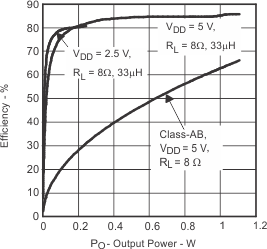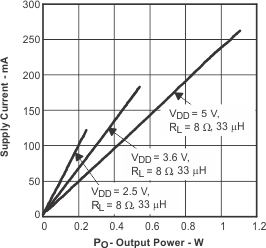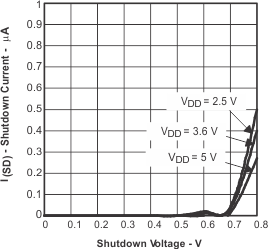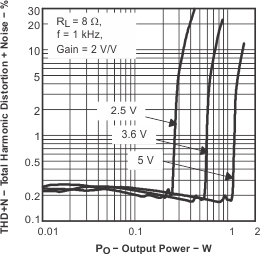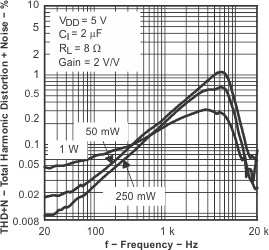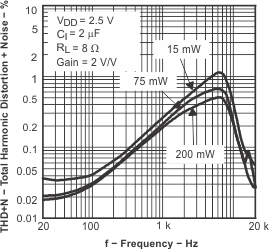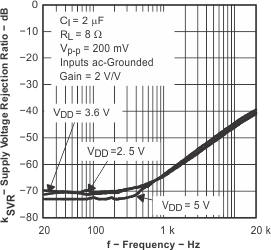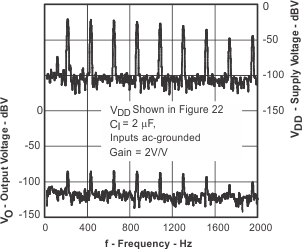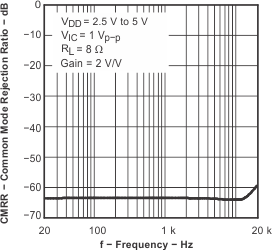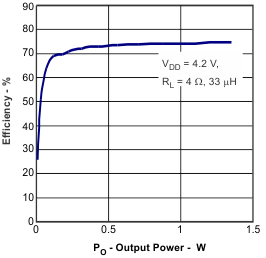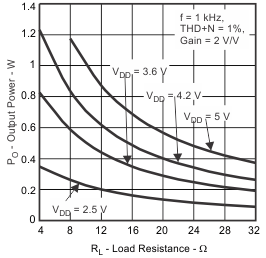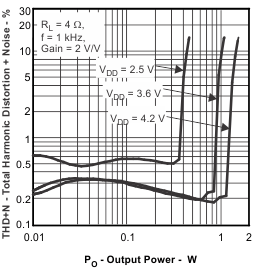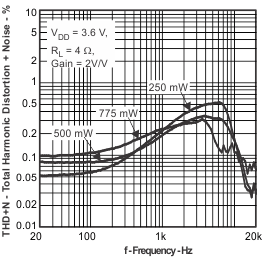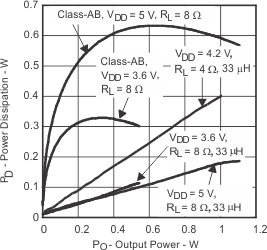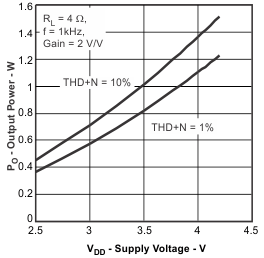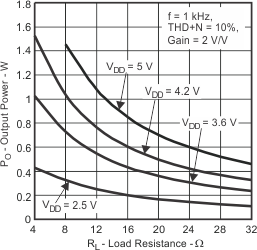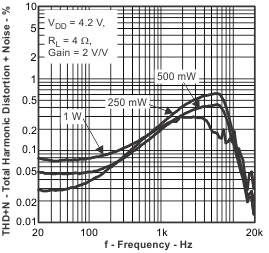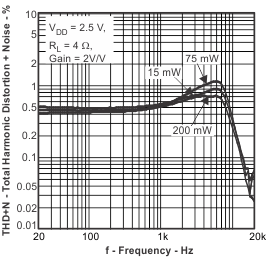SLOS369G July 2002 – October 2015 TPA2005D1
PRODUCTION DATA.
- 1 Features
- 2 Applications
- 3 Description
- 4 Revision History
- 5 Device Comparison Table
- 6 Pin Configuration and Functions
- 7 Specifications
- 8 Parameter Measurement Information
- 9 Detailed Description
- 10Application and Implementation
- 11Power Supply Recommendations
- 12Layout
- 13Device and Documentation Support
- 14Mechanical, Packaging, and Orderable Information
封装选项
请参考 PDF 数据表获取器件具体的封装图。
机械数据 (封装 | 引脚)
- DGN|8
- DRB|8
散热焊盘机械数据 (封装 | 引脚)
订购信息
7 Specifications
7.1 Absolute Maximum Ratings
over operating free-air temperature range (unless otherwise noted)(1)| MIN | MAX | UNIT | |||
|---|---|---|---|---|---|
| VDD | Supply voltage(2) | In active mode | –0.3 | 6 | V |
| In SHUTDOWN mode | –0.3 | 7 | V | ||
| VI | Input voltage | –0.3 | VDD + 0.3 V | V | |
| TA | Operating free-air temperature | –40 | 85 | °C | |
| TJ | Operating junction temperature | –40 | 85 | °C | |
| Tstg | Storage temperature | –65 | 150 | °C | |
| RL | Load resistance | 2.5 ≤ VDD ≤ 4.2 V | 3.2 (Minimum) | Ω | |
| 4.2 < VDD ≤ 6 V | 6.4 (Minimum) | Ω | |||
(1) Stresses beyond those listed under Absolute Maximum Ratings may cause permanent damage to the device. These are stress ratings only, which do not imply functional operation of the device at these or any other conditions beyond those indicated under Recommended Operating Conditions. Exposure to absolute-maximum-rated conditions for extended periods may affect device reliability.
(2) For the MSOP (DGN) package option, the maximum VDD should be limited to 5 V if short-circuit protection is desired.
7.2 ESD Ratings
| VALUE | UNIT | |||
|---|---|---|---|---|
| V(ESD) | Electrostatic discharge | Human-body model (HBM), per ANSI/ESDA/JEDEC JS-001(1) | ±3000 | V |
| Charged-device model (CDM), per JEDEC specification JESD22-C101(2) | ±1500 | |||
(1) JEDEC document JEP155 states that 500-V HBM allows safe manufacturing with a standard ESD control process.
(2) JEDEC document JEP157 states that 250-V CDM allows safe manufacturing with a standard ESD control process.
7.3 Recommended Operating Conditions
over operating free-air temperature range (unless otherwise noted)| MIN | NOM | MAX | UNIT | |||
|---|---|---|---|---|---|---|
| VDD | Supply voltage | 2.5 | 5.5 | V | ||
| VIH | High-level input voltage | SHUTDOWN | 2 | VDD | V | |
| VIL | Low-level input voltage | SHUTDOWN | 0 | 0.8 | V | |
| RI | Input resistor | Gain ≤ 20 V/V (26 dB) | 15 | kΩ | ||
| VIC | Common mode input voltage range | VDD = 2.5 V, 5.5 V, CMRR ≤ –49 dB | 0.5 | VDD-0.8 | V | |
| TA | Operating free-air temperature | –40 | 85 | °C | ||
7.4 Thermal Information
| THERMAL METRIC(1) | TPA2005D1 | UNIT | ||||
|---|---|---|---|---|---|---|
| ZQY (MicroStar Junior) | GQY (MicroStar Junior) | DRB (VSON) | DGN (MSOP PowerPAD) | |||
| 15 PINS | 15 PINS | 8 PINS | 8 PINS | |||
| RθJA | Junction-to-ambient thermal resistance | 92.7 | 92.7 | 50.9 | 57.2 | °C/W |
| RθJC(top) | Junction-to-case (top) thermal resistance | 120.5 | 120.5 | 66.2 | 53.8 | °C/W |
| RθJB | Junction-to-board thermal resistance | 104 | 104 | 25.9 | 33.7 | °C/W |
| ψJT | Junction-to-top characterization parameter | 3.1 | 3.1 | 1.4 | 1.9 | °C/W |
| ψJB | Junction-to-board characterization parameter | 44.8 | 44.8 | 26 | 33.47 | °C/W |
| RθJC(bot) | Junction-to-case (bottom) thermal resistance | n/a | n/a | 7 | 6.4 | °C/W |
(1) For more information about traditional and new thermal metrics, see the Semiconductor and IC Package Thermal Metrics application report, SPRA953.
7.5 Electrical Characteristics
TA = 25°C, over operating free-air temperature range (unless otherwise noted)| PARAMETER | TEST CONDITIONS | MIN | TYP | MAX | UNIT | |
|---|---|---|---|---|---|---|
| |VOS| | Output offset voltage (measured differentially) | VI = 0 V, AV = 2 V/V, VDD = 2.5 V to 5.5 V | 25 | mV | ||
| PSRR | Power supply rejection ratio | VDD = 2.5 V to 5.5 V | –75 | –55 | dB | |
| CMRR | Common mode rejection ratio | VDD = 2.5 V to 5.5 V, VIC= VDD/2 to 0.5 V, VIC= VDD/2 to VDD- 0.8 V |
–68 | –49 | dB | |
| |IIH| | High-level input current | VDD = 5.5 V, VI = 5.8 V | 50 | μA | ||
| |IIL| | Low-level input current | VDD = 5.5 V, VI = 0.3 V | 1 | μA | ||
| I(Q) | Quiescent current | VDD = 5.5 V, no load | 3.4 | 4.5 | mA | |
| VDD = 3.6 V, no load | 2.8 | |||||
| VDD = 2.5 V, no load | 2.2 | 3.2 | ||||
| I(SD) | Shutdown current | V (SHUTDOWN) = 0.8 V, VDD = 2.5 V to 5.5 V | 0.5 | 2 | μA | |
| rDS(on) | Static drain-source on-state resistance | VDD = 2.5 V | 770 | mΩ | ||
| VDD = 3.6 V | 590 | |||||
| VDD = 5.5 V | 500 | |||||
| Output impedance in SHUTDOWN | V (SHUTDOWN) = 0.8 V | >1 | kΩ | |||
| f(sw) | Switching frequency | VDD = 2.5 V to 5.5 V | 200 | 250 | 300 | kHz |
| Gain |
 |
 |
 |
 |
||
7.6 Operating Characteristics
TA = 25°C, Gain = 2 V/V, RL = 8 Ω (unless otherwise noted)| PARAMETER | TEST CONDITIONS | MIN | TYP | MAX | UNIT | ||
|---|---|---|---|---|---|---|---|
| PO | Output power | THD + N= 1%, f = 1 kHz, RL = 8 Ω | VDD = 5 V | 1.18 | W | ||
| VDD = 3.6 V | 0.58 | ||||||
| VDD = 2.5 V | 0.26 | ||||||
| THD + N= 10%, f = 1 kHz, RL = 8 Ω | VDD = 5 V | 1.45 | W | ||||
| VDD = 3.6 V | 0.75 | ||||||
| VDD = 2.5 V | 0.35 | ||||||
| THD+N | Total harmonic distortion plus noise | PO = 1 W, f = 1 kHz, RL = 8 Ω | VDD = 5 V | 0.18% | |||
| PO = 0.5 W, f = 1 kHz, RL = 8 Ω | VDD = 3.6 V | 0.19% | |||||
| PO = 200 mW, f = 1 kHz, RL = 8 Ω | VDD = 2.5 V | 0.20% | |||||
| kSVR | Supply ripple rejection ratio | f = 217 Hz, V(RIPPLE) = 200 mVpp
Inputs ac-grounded with Ci = 2 μF |
VDD = 3.6 V | –71 | dB | ||
| SNR | Signal-to-noise ratio | PO= 1 W, RL = 8 Ω | VDD = 5 V | 97 | dB | ||
| Vn | Output voltage noise | VDD = 3.6 V, f = 20 Hz to 20 kHz, Inputs ac-grounded with Ci = 2 μF |
No weighting | 48 | μVRMS | ||
| A weighting | 36 | ||||||
| CMRR | Common mode rejection ratio | VIC = 1 Vpp , f = 217 Hz | VDD = 3.6 V | –63 | dB | ||
| ZI | Input impedance | 142 | 150 | 158 | kΩ | ||
| Start-up time from shutdown | VDD = 3.6 V | 9 | ms | ||||
7.7 Typical Characteristics
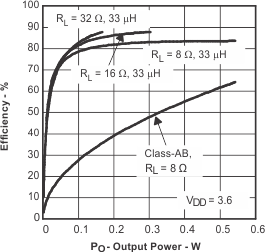
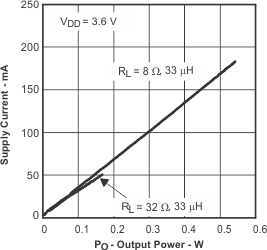
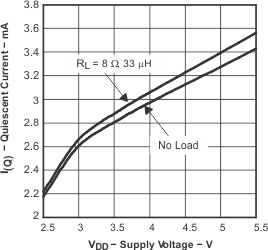
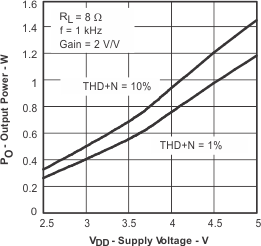
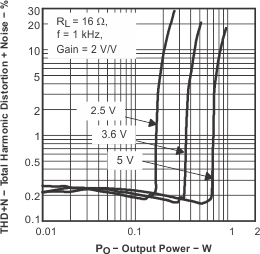
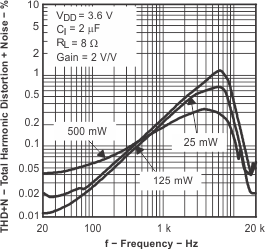
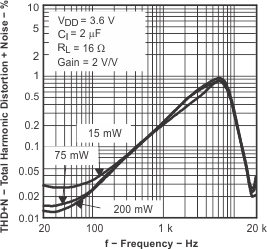
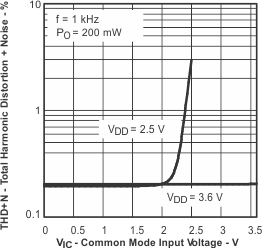
Common Mode Input Voltage
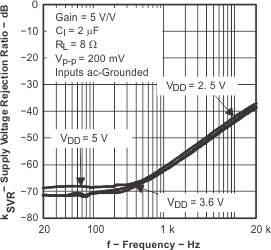
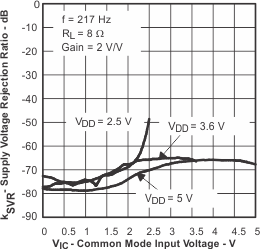
Common-mode Input Voltage
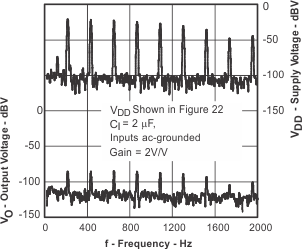
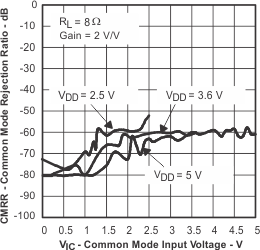
Common-mode Input Voltage
